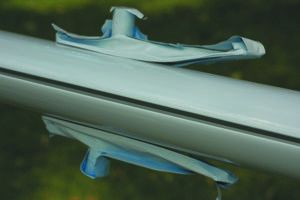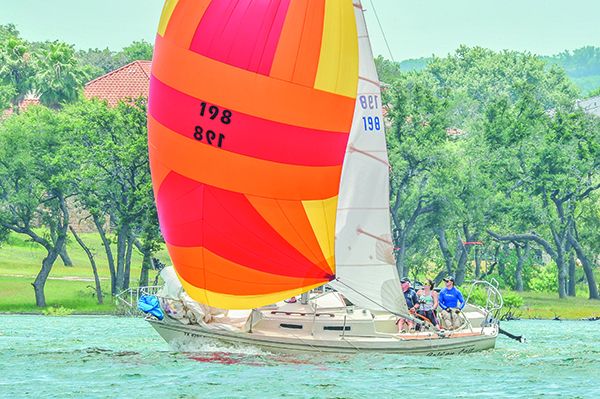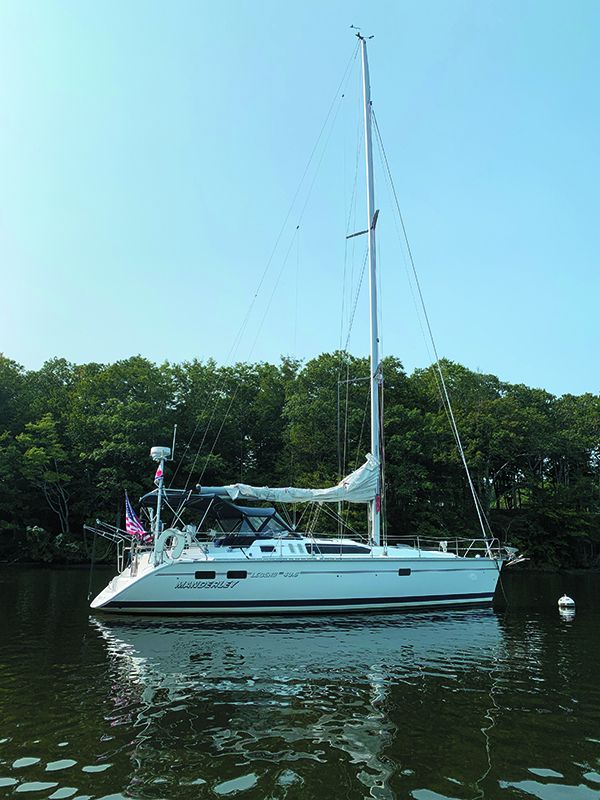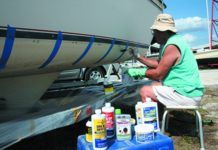Mast paint
What is the best way to repair the blisters on my painted aluminum mast? Blisters occur near pop rivets or other attachments to mast. Thanks for any help.
Tim Nordhaus
Whoodogi, Pacific Seacraft 40
Gloucester Point, VA
Paint failure near hardware attachments can often be traced to galvanic corrosion caused by the reaction between dissimilar metals (like stainless-steel and aluminum) that have not been properly isolated. In such cases, the conservative approach would be to remove the hardware, repair as needed, refinish and reinstall properly isolated hardware. We will be looking more closely at refitting/refinishing aluminum masts and spars in an upcoming report.

After 200,000 Miles
John Neal’s “Refitting After 200,000 Miles” was thorough and practical (see PS May 2017). For many of us, cruising shorter coastal or shorter passages, Garmin Inreach is a good economical substitute for SSB or Iridium Go. I’ve had both the latter on my Norseman 447, and I do fine without them now that my cruising is limited to the Sea of Cortez and Pacific coast of Mexico on a Gemini 105Mc catamaran.
The high pressure pump for the Village Wonder watermaker we used in the South Pacific failed and the yard that promised to rebuild it lost it, though they did reimburse me for its value. We opted for removing the rest of the installation and relied on collecting rain water and the occasional refill of tanks with collapsible 2.5- and 5-gallon water jugs. We used Sawyer water filters and donated many of them to villagers after cyclone Winston devastated Fiji in 2016. Now we keep a Katadyn survivor 35 manual water maker as a backup but have not needed to use it on shorter cruises.
We use an RV water filter attached to a hose when filling tanks from dockside or shore taps, and a Brita pitcher type filter for drinking. An inexpensive inverter supplied 110 power from our five-battery [lead-acid] system on the Norseman, and a similar system works well in the three battery bank on the Gemini. A Honda 1 KW portable generator backs that up and is good insurance against accidentally depleting the batteries totally.
Our 100 watt solar panel has so far served us well. Our Raritan marine head, although is functioning well, will soon be replaced by a composting toilet. And last but not least, having lost an undue number of fish when gaffing them at the boat, we now rely on a net.
Brian Bouch,
Gemini 105Mc
Mazatlan, Mexico

Brighter, warmer days may seem far away in the northern regions of the planet, but spring sneaks up faster than we imagine, which means it’s time to start on that pre-
season to-do list.
- If you’re looking to upgrade deck hardware this year, there is a slew of related tests at www.practical-sailor.com.
— We evaluated snatch blocks in the July 2007 issue, looking at blocks from Antal, Garhauer, Harken, Lewmar, Schaefer, and Wichard. In the August 2008 issue, we featured a test update that put a line of blocks from Ronstan in the mix.
—Testers dove into the crowded world of shackles in the July 2014 issue. Now is a good time to inspect old shackles for signs of wear or failure, and to replace any that are questionable.
—If you’re upgrading your running rigging to high-tech lines, you’ll want to consider replacing your old rope clutches too. In the November 2014 issue, we reviewed a range of new rope clutches engineered to be grippier to handle today’s slick, high-tech fiber rope.
- If you unstep your mast each winter, it’s a great time to cleanup those halyards and sheets. Before you do, be sure to read our extensive report on washing ropes in the July 2011 issue. It answers those often-asked questions like whether you should use bleach or fabric softener; should they be laundered in a washing machine or bucket? The January 3, 2019 Inside Practical Sailor blog post offers a short recap of the article as well.
- Another chore you can cross off is cleaning—or clearing—foggy Eisenglass. In the May 2014 issue, we reviewed several products designed to clean or revive aged, clear-vinyl windows.
- Rewiring this winter? Check out our e-book series on electrical systems. The series includes volumes on batteries; electrical system installation (grounding and lightning protection); alternative energy; AC systems; and panels, charging, and monitoring. Check it out at our online bookstore at www.practical-sailor.com.
Lifesling
Regarding your report on Lifesling webbing failures (see “Lifesling Webbing Beckets Fail,” PS August 2016), no one can dispute the poor quality of the Lifesling bag—but how many have practiced retrieving a man overboard? We did so years ago as a yacht club learning exercise. The object was only to lift someone on board. Most of the man overboard volunteers, if not all, complained that the sling’s position under your arms nearly breaks your back when you’re lifted to the deck. This was in ideal conditions—no waves. We concluded that in a rough sea conditions the victim would not survive the retrieval, and if so would most likely be paralyzed.
Bill Siwik
Manderley, Hunter 40
Stonington, CT
The strengths and weaknesses of rescue slings are well-documented in “Slings, Scoops, and Ladders,” our most detailed report on lifting devices (see PS January 2006 online). For a complete look at averting a crew overboard disaster, our ebook covers the topic from top to bottom (see “Man Overboard Prevention & Recovery,” www.practical-sailor.com/product/mob-prevention-recovery).
How Much Ammonia?
Your DIY laundry report (see “Liveaboard Sailors’ Laundry Hacks,” December 2019) did not specify how much of any cleaning agent is used—how much ammonia or Burst?
Also missing is a conclusion/best practice—is ammonia the winner or not? How much ammonia are we bringing on board for, say, 2-3 washes for the crew? How were washes done in your test? Hand agitating? Soaking? Is the O-Cedar bucket that you tested involved or not, or are you recommending it be used just for wringing?
Will Gerstmyer
Tasha, Freedom 36
South Portland, Maine
We apologize for not making this clearer in the test and are currently updating the online report to answer these questions. Our tester, Technical Editor Drew Frye used about 1/2 the recommended amount of ammonia, since sailing clothes are not that dirty (just smelly) and we know rinsing is going to be the challenge. He used 4 ml of HE detergent or ammonia per gallon (5 ml = one teaspoon). This would do a few shirts.
Each washing was a uniform 20 ordinary plunger strokes. The spin-dry was with a uniform 20 pedal pumps of a plastic mop spinner. As for the O-Cedar spinner, it worked well. We wouldn’t bother with it unless we were cruising full-time, in which case, we would get a rag-wringer used by car wash companies.
In our view, ammonia is the way to go when water is scarce. The clothes will be fresh and wearable, without saltwater stiffness. Washing in saltwater, even with multiple rinses, resulted in damp, scratchy, nearly unwearable clothes. In fact, by the time you rinse enough for the clothes to be wearable, you will use less water if you are just using fresh water with minimal detergent from the start. Slightly brackish water can be a reasonable alternative for the coastal sailor. For the most conservative use of water, wash in freshwater and ammonia and use only a minimal freshwater rinse.
We would not use ammonia on wool. In fact, you really have very little chance of laundering wool if you are short on water, and drying is a challenge. The same characteristics that make it warm when wet, make it far more difficult to launder on board. Wool’s unique advantage is that it is a natural material that can be sustainably sourced. We’ve tested its insulation properties backward and forward, and found other winter blends that are more practical to have on board. And if sustainability is your chief concern, Patagonia offers many alternatives that adhere to their strict environmental ethic.

No to Rock Wool
Regarding reader Patrick Bryan’s Rock query about using rock wool for engine room noise insulation (see Mailport PS January 2021). Rock wool doesn’t work well on low frequencies but it is useful for packing large voids like those behind the engine. It’s fire proof and will drain any water.
On my Cape Dory 25D, I have an irregularly-shaped engine compartment, so I had to first create an engine “box” using thin ply, a hot-glue gun, and spray foam to seal all of the openings to adjacent compartments. (The engine space has exterior vents). Because of the irregular shapes involved, I found adhesive-backed automotive sound-deadening mat (Kilmat) worked well. It does not work as well as I’d hoped on low frequencies. Interestingly, when the engine was covered, the most noise attenuation was under the engine. The project was very labor intensive.
Peter Wordsworth
via PS Online

Safety Boat Protocol
Regarding the sad report of the young sailor’s death in Florida, (see “The Tragedy of the Driverless Dinghy,” PS January 2020), during my US Sailing Level 1 certification, we were told to turn motors off during assistance or rescue procedures. Also, some feel that a “safety” boat should have two people on board. During a rescue, one person has his hands full.
Bill Records
Cafe Au Lait. Pearson 26OD
Austin, Texas
Correction
Capt. Bill Herrmann’s web address is www.uscgmaster.com, another URL appeared in the January 2021 issue. Moya-Manzi is a Beneteau 321. Other information appeared in the January 2021 Mailport.
Practical Sailor welcomes reader comments and questions. Send email & reader photography (digital .jpeg 1MB or greater) to practicalsailor@ belvoir.com; include your name, homeport, boat type, and boat name. Send Gear Graveyard samples to PS at 1600 Bayshore Rd., Nokomis, FL 34275





































